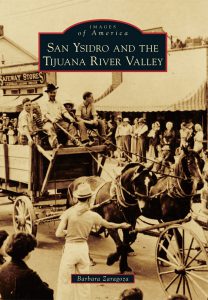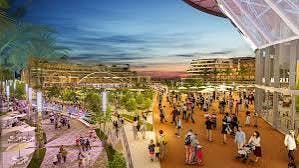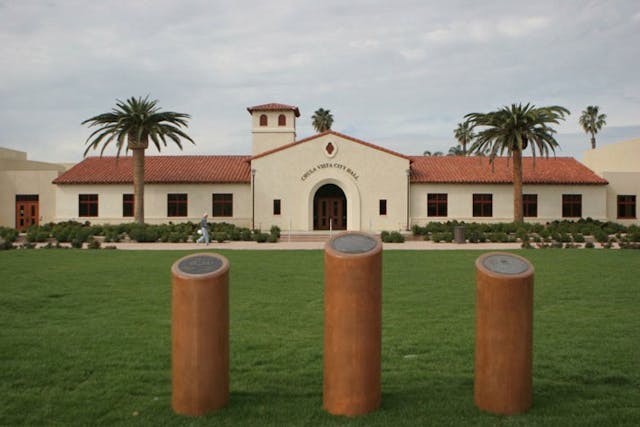San Ysidro’s history highlighted in photographic book
Part I of II
By Pablo J. Sáinz
 A new, beautifully illustrated book is giving San Ysidro its proper place in U.S.-Mexico history.
A new, beautifully illustrated book is giving San Ysidro its proper place in U.S.-Mexico history.
San Ysidro and the Tijuana River Valley, part of Arcadia Publishing’s Images of America series, tells the rich history of the San Ysidro area through more than 200 vintage photographs, with insights and commentary by local historian and writer Barbara Zaragoza.
With a history degree from Harvard, Zaragoza embarked on the task of compiling the photos and doing the research to create this book, which was long overdue for San Ysidro.
La Prensa San Diego interviewed Barbara Zaragoza about her new book, which was released last month, and about all the interesting historical findings she made while working on this beautiful project, which we’re sure will empower the residents of San Ysidro and the Tijuana River Valley.
The following is the first part of a two-part series.
La Prensa San Diego: It is known that, historically, San Ysidro has been left behind by the City of San Diego, in terms of infrastructure, and other public services. Based on your research, is this true? Has San Ysidro been the ugly duckling of the city?
Barbara Zaragoza: My research does show that the San Ysidro and Tijuana River Valley communities have, at times, not been heard by the City of San Diego and also by the State of California and the federal government.
Alicia Jimenez’s work, for example, shows that. Traditionally, residents have noticed that streets haven’t been properly paved and trash collection hasn’t happened regularly. So in the 1990’s, Jimenez and a team of good-willed residents began to clean the streets of San Ysidro. The money she made then went to buying food and clothing for the needy of the community. She also helped, alongside some wonderful visionaries like Abuelita, to rally the State of California to pass Prop C, a $200 million bond that would renovate the crumbling schools.
But the history of San Ysidro being ‘left behind’ goes further back than the 1990’s. San Ysidro was annexed by a minority of residents into San Diego in 1957, but the area was not a contiguous part of the city, separated from it by Chula Vista. In 1959, vast California legislation gave Jakob Dekema—the head engineer for District 11 of the California Division of Highways — the task of building the freeways we have in San Diego County today. He believed that the greatness of Rome was based on its roads. He also believed that freeways should come before the needs of communities and historic preservation.
Dekema led the efforts to construct the I-805 and I-5, which cut right through San Ysidro, thereby fragmenting the community, creating more vehicle pollution and making the area more aesthetically ugly.
The federal government, meanwhile, started to create a chain link fence already in 1955 in response to Cold War fears of Red China smuggling drugs through the U.S.-Mexico border in order to dope up American youth. The fence started to stretch from San Ysidro through the Tijuana River Valley.
Already at that time, the government didn’t take into account the environmental damage such a fence would create, let alone the opinions of the residents in the region. Still for many decades, residents reported to me that they could go back and forth through the border within 15 minutes or less. In the 1990’s with Clinton’s Operation Gatekeeper, military landing mat replaced the chain link fence and the number of border patrol increased substantially. The more the border fence grew, the more families were separated and unable to see one another because they lived on either side of an increasingly policed and prohibited boundary line.
LPS: What is the most surprising fact you found about San Ysidro while researching the book?
BZ: That is a hard question because there were quite a few surprises.
The first would be that real estate developers came here in the 1880’s because they wanted to create a tourist destination at the border. These developers were outsiders who had grand visions of hot springs, tours to the boundary monuments, lavish hotels and more. All their dreams collapsed during a real estate bust cycle — much like the one we just experienced a few years back.
The second would be how significant the Chinese threat seemed to be, from concerns over illegal immigration after the passage of the Chinese Exclusion Act in 1882 when special Chinese inspectors were hired at the border, to the Cold War threat of Chinese drug smuggling. A Chinese threat at a U.S.-Mexico border? That surprised me.
The third and most important discovery was Guadalupe Gonzalez, the first Mexican man to settle in San Ysidro. The border area that we know today as the Tijuana River Valley and San Ysidro back then also included Tia Juana on the U.S. side. Old timers remember people of many different ethnic and religious backgrounds living in the border region: Jews, Japanese, Chinese, East Europeans and a very large Mexican population all integrated together.
Whereas segregation existed in places like the South, old timers explained to me on numerous occasions that they and their neighbors all lived very integrated in in this region.
LPS: How different is the San Ysidro of today to the San Ysidro of the past?
BZ: Some of the differences are the freeways, the port of entry having about 50 million people passing through the community annually and the Las Americas outlet malls, which have replaced the ‘mom-and-pop’ stores such as Cesar Soto’s pharmacy.
But there is something more important than that. Today, San Ysidro is more than ninety percent Hispanic. This demographic shift was a very gradual development. During the days of Prohibition, American tourists flocked down to Tijuana to enjoy gambling, alcohol, prostitution and opium dens that were illegal in the U.S. The owners of the Tijuana casinos and race tracks were generally white and they hired mostly white people. The employees at these establishments generally chose to live in quieter San Ysidro with their families. When Mexico changed the laws to make it harder for Americans to obtain work visas (because the rowdy American tourists posed a menace to Mexican residents in Tijuana), those white Americans left San Ysidro and moved up North to find new work.
Decades later, in 1964 when the Bracero Program ended, many Mexicans remained on the U.S. side of the border for their work. However, they still wanted to remain close to their families and their culture, so San Ysidro was a natural place for them settle. Since the border patrols weren’t very strict during the sixties, it was easy for people to cross the border and visit their families for a day or a weekend.
Because San Ysidro is now predominantly Hispanic, the community has some unique features and concerns. Casa Familiar, for example, started out working to provide mental health services to non-English language speakers. Cesar Chavez came to speak at the Civic Center in San Ysidro precisely because this was where people were concerned with rights for farm workers. Most importantly, when you arrive in San Ysidro, you will experience a bilingual town. That’s, of course, what I love best about San Ysidro. It’s a dual-lingual world.
LPS: You dedicate the book to the residents of San Ysidro, past and present, “who have managed to cultivate a small-town feel in spite of the federally managed San Ysidro Port of Entry.” What does having the largest land port of entry in the U.S. mean for this small community?
BZ: San Ysidro has always co-existed with the ever present boundary line. Starting with the 1920’s when Tijuana became “Vice City,” San Ysidro Boulevard catered to tourists passing through. During the 1970’s, numerous Casas de Cambios were established along the boulevard. Many businesses in San Ysidro necessarily cater to border crossers and, therefore, the town’s economic success often depends upon the politics of the border.
For residents, the border also means you can walk and then suddenly, you can walk no further. You are confronted by a wall, even as you can see what’s behind it. What I found was that the boundary fence creates many unique issues for residents that people, for example, in the rest of the City of San Diego don’t face. The ecology has been altered many times, which has affected the ranches and farms. When, as only one example, Smuggler’s Gulch was filled in and a double fence created, the federal government ignored the Clean Air Act, the Endangered Species Act and the Coastal Zone Management Act.
Among the many implications of border construction, these increased barriers mean longer wait times at the border, which translates into higher pollution levels for residents.
In part 2, author and historian Barbara Zaragoza will discuss the environmental history of San Ysidro and the Tijuana River Valley, as well as what the future might hold for this border community.



 Arturo Castañares
Arturo Castañares


